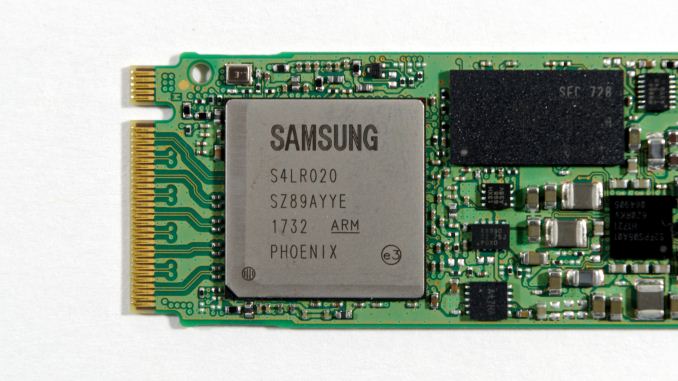The Samsung PM981 SSD Review (512GB, 1TB): Next Generation Controller And 3D NAND
by Billy Tallis on November 30, 2017 9:02 AM ESTConclusions
The Samsung PM981 looks poised to sit as a potential base for a 980 Evo equivalent in 2018. It offers a healthy generational improvement to performance due to the combination of a new controller and Samsung's new 64-layer 3D TLC NAND. The previous generation (PM961 for OEMs, 960 EVO for retail) was already the fastest TLC-based client SSD, and it outperforms many MLC-based SSDs. By improving on that level of performance, the PM981 has caught up to or surpassed the MLC-based 96x drives on many tests, setting new records not just for TLC-based drives but for client SSDs as a whole.
The Samsung PM981 offers performance that is more well-rounded than any other TLC-based SSD. The faster 1TB capacity is almost completely immune to the typical pitfalls of using TLC NAND; it is almost impossible for a real-world workload to trigger the kind of nasty slowdown that typically indicates a full SLC write cache or something else causing a lot of background work for the SSD controller.
The 512GB PM981 doesn't set records except for within its own product class, but it too is a meaningful improvement over its predecessors. The 512GB model doesn't handle heavy workloads quite as well as the larger model, but it still beats any other TLC-based option.
Both drives raise the bar for how well TLC SSDs should perform. On lighter workloads, they set a new standard that even MLC-based drives have trouble reaching. For almost everyone, the fact that the PM981 uses TLC NAND is no cause for concern because the performance defies the expectations for TLC SSDs. They are obviously great choices for OEMs to offer in high-performing notebook computers, depending on the power consumption, which we will test when our testing equipment is fixed.
Enthusiasts will have to wait until CES in January or some later event to hear about Samsung's next SSDs based on the PM981, which is likely to be called the 980 Evo if it follows previous naming conventions. These PM981 drives, if you can source them on the grey market, may be a reasonable choice for impatient system builders wanting to put the latest TLC into their systems today. As always though, OEM drives purchased on the grey market come with no warranty from the manufacturer and firmware updates may be hard to come by, so they aren't for everyone.











53 Comments
View All Comments
peevee - Thursday, November 30, 2017 - link
The most important parameter is the sustained random read, when the user have to actually wait (buffered writes let you continue working right away and it is almost impossible to overflow write caches during normal desktop usage).And even SSDs continue to suck in this parameter. 60MB/s? Booo...
Although testing on 4k random is too strict, NTFS runs are usually 16 clusters (64k).
wyewye - Thursday, November 30, 2017 - link
This is why I stopped coming to Anandtech daily: you keep excluding top offers from Intel in your SSD benchmarks.Samsung shills!
ddriver - Thursday, November 30, 2017 - link
LOL, second funniest thing I heard this weekddrіver - Thursday, November 30, 2017 - link
The first one was actually a joke with a priest and a rabbi... Can't really remember the punchline now.lilmoe - Thursday, November 30, 2017 - link
Thank you, competing OEMs. Thanks to you, Samsung isn't even trying anymore. Just when I thought they'd introduce 64 layer SLC, they decide to go full TLC, because why try harder? Screw you too, Samsung.ddrіver - Thursday, November 30, 2017 - link
Exactly my point. It's not so hard for them to go to 64 or 128 or even 256 layer SLC, with even an 8TB SSD. That should be in the range of $500-$600 to be competitive. Instead they choose to deliver a drive that simply doesn't massively improve on every single data point relative to the old generation. It might be good for 95% of consumers but they don't even think of us, professionals.Just downloading a game nowadays takes 50-100GB of SSD writes. At this rate who know how long I'm going to be able to use this kind of SSD. Greedy people selling to sheeple. Wake up!
zodiacfml - Friday, December 1, 2017 - link
Samsung, like Intel, has no competition taking their sweet time with each iteration.AnnonymousCoward - Saturday, December 2, 2017 - link
In many cases Samsung costs more and has less endurance; the competition is better.melgross - Friday, December 1, 2017 - link
It’s good to see that manufacturers are so far in advance of where they already are:“Other M.2 PCIe SSD vendors have used that tactic and many have also released drives with more substantial heatspreaders or heatsinks in the future.”
trumanhw - Sunday, December 31, 2017 - link
1TB 960 Pro looks like it's the shiznit. By far my choice... cost per dollar, and as they said, impunity to the negatives seen in other sizes and models. Where it's not the first, it's so close in the other positions as to require measurement to verify. As always, thank you anand -- you guys rock.